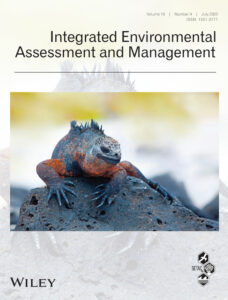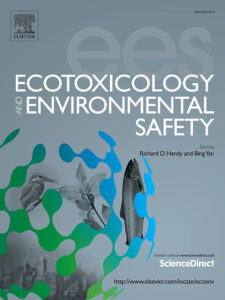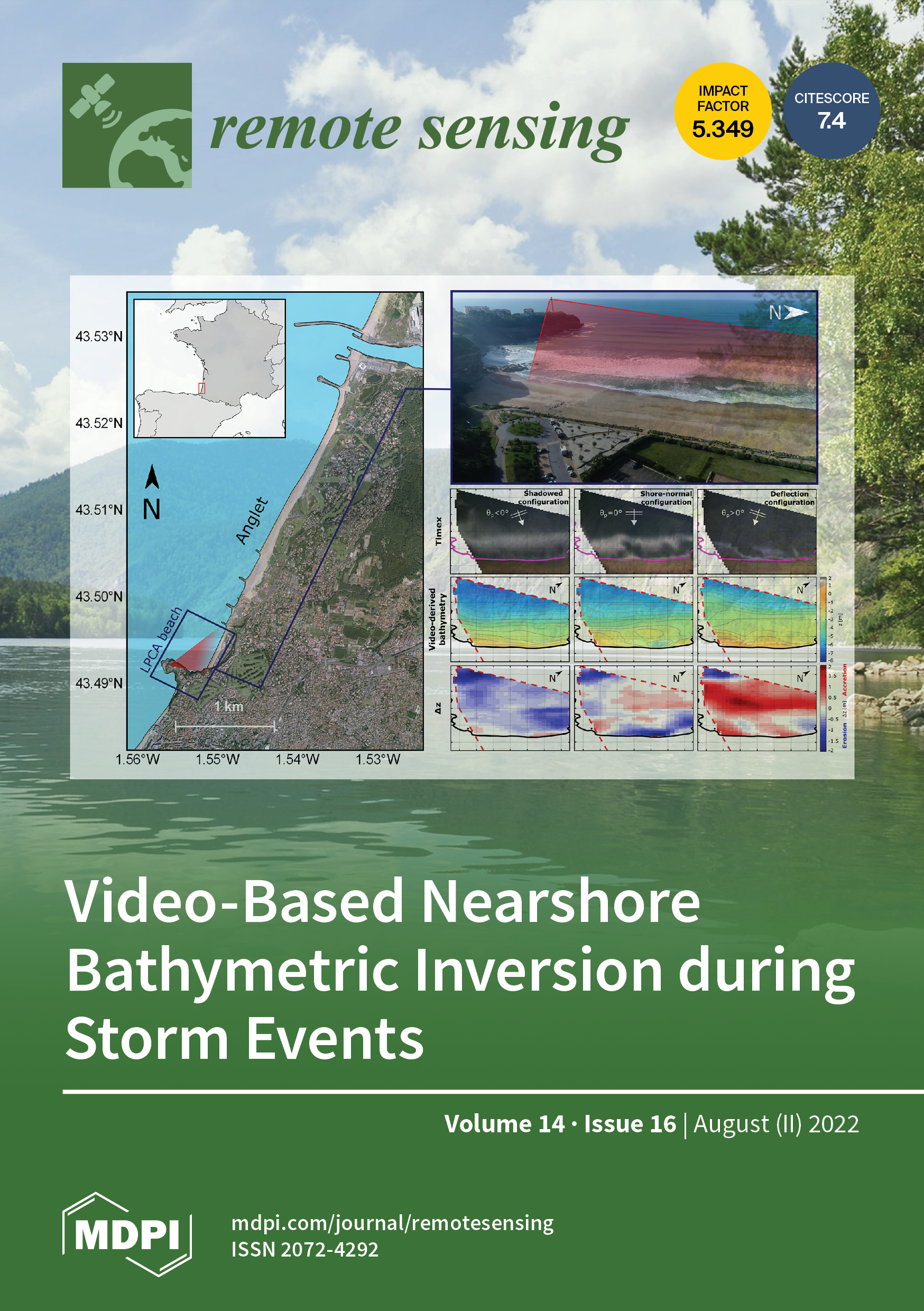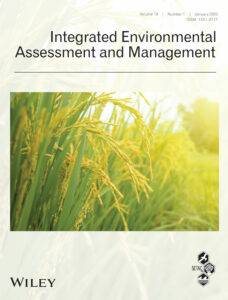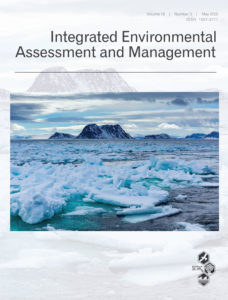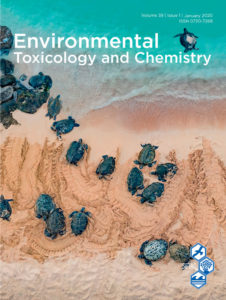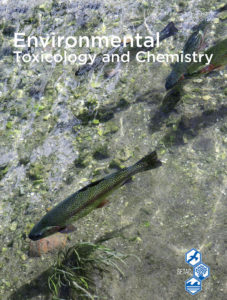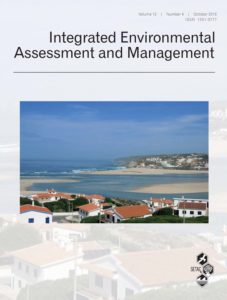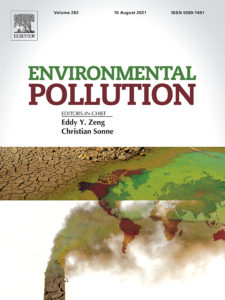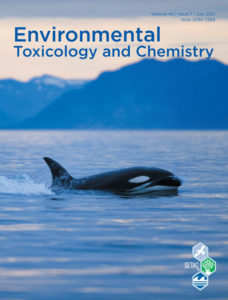2023
Holmes, C.M. (Applied Analysis Solutions, LLC); Pritsolas, J. (Southern Illinois University Edwardsville); Randall Pearson, R. (Southern Illinois University Edwardsville); Butts-Wilmsmeyer, C. (Southern Illinois University Edwardsville); Schad, T. (Bayer CropScience)
In: Applied Sciences, vol. 13, iss. 22, no. 12467, 2023.
Abstract | Links | Tags: 2023, Peer-Reviewed Publication
@article{timeseriesgrassland,
title = {Time-Series Characterization of Grassland Biomass Intensity to Examine Management Change at Two Sites in Germany Using 25 Years of Remote Sensing Imagery},
author = {Holmes, C.M. (Applied Analysis Solutions, LLC) and Pritsolas, J. (Southern Illinois University Edwardsville) and Randall Pearson, R. (Southern Illinois University Edwardsville) and Butts-Wilmsmeyer, C. (Southern Illinois University Edwardsville) and Schad, T. (Bayer CropScience)},
url = {https://www.mdpi.com/2076-3417/13/22/12467, View Online
https://appliedanalysis.solutions/wp-content/uploads/2023/12/Holmes-2023-Time-Series-Characterization-of-Grassland-Biomass-Intensity-to-Examine-Management-Change-at-Two-Sites-in-Germany-Using-25-Years-of-Remote-Sensing-Imagery.pdf, View Document},
doi = {10.3390/app132212467},
year = {2023},
date = {2023-11-17},
urldate = {2023-11-17},
journal = {Applied Sciences},
volume = {13},
number = {12467},
issue = {22},
abstract = {In cultivated landscapes, grasslands are an important land use type for insect life. Grassland management practices can have a significant impact on insect ecology. For example, intense fertilization and frequent cutting can reduce the diversity and abundance of insects by destroying their habitat and food sources. Thus, the quality of grassland habitat for insect development depends on its management intensity. The intensification of grassland production is discussed as one factor contributing to the decline in insect biomass over recent decades. Characterizing grassland changes over time provides one piece to the larger puzzle of insect decline. We analyzed landscape-level trends in grassland biomass near Orbroich and Wahnbachtal in North Rhine-Westphalia, Germany, over a 25-year period. In both areas, pronounced insect biomass decline had been observed. More than 430 Landsat images were used. An image normalization process was developed and employed to ensure that observed changes over time were attributed to grassland changes and not systemic changes inherent within image time series. Distinct clusters of grassland parcels were identified based on intensity and temporal changes in biomass using Normalized Difference Vegetation Index (NDVI) as an indicator. Cluster separability was confirmed using the Transform Divergence method. The results showed clusters having periods of distinct trends in vegetation biomass, indicating changes in grassland agronomic and/or management practices over time (e.g., fertilization, increased silage production). Changes in management practices coincided with regional trends in cultivation as documented by official statistics. We demonstrated the feasibility of using 100+ images over multiple decades to perform a long-term remote sensing analysis examining grassland change. These temporally expansive and spatially detailed trends of grassland change can be included as factors in the multi-variate analysis of insect decline. The methodology can be applied to other geographic areas. Such improved insights can support informed landscape design and cultivation patterns in relation to insect ecology and the broader context of biodiversity enhancement.},
keywords = {2023, Peer-Reviewed Publication},
pubstate = {published},
tppubtype = {article}
}
Schad, T. (Bayer AG); Bub, S. (Rheinland‐Pfälzische Technische Universität); Wang, M. (WSC Scientific GmbH); Holmes, C.M. (Applied Analysis Solutions, LLC); Kleinmann, J. (WSC Scientific GmbH); Hammel, K. (Bayer AG); Ernst, G. (Bayer AG); Preuss, T.G. (Bayer AG)
A spatiotemporally explicit modeling approach for more realistic exposure and risk assessment of off‐field soil organisms Journal Article
In: Integrated Environmental Assessment and Management, vol. 20, iss. 1, pp. 263-278, 2023.
Abstract | Links | Tags: 2023, Peer-Reviewed Publication
@article{2023modeling,
title = {A spatiotemporally explicit modeling approach for more realistic exposure and risk assessment of off‐field soil organisms},
author = {Schad, T. (Bayer AG) and Bub, S. (Rheinland‐Pfälzische Technische Universität) and Wang, M. (WSC Scientific GmbH) and Holmes, C.M. (Applied Analysis Solutions, LLC) and Kleinmann, J. (WSC Scientific GmbH) and Hammel, K. (Bayer AG) and Ernst, G. (Bayer AG) and Preuss, T.G. (Bayer AG)},
url = {https://setac.onlinelibrary.wiley.com/doi/10.1002/ieam.4798, View Online
http://appliedanalysis.solutions/wp-content/uploads/2023/08/Schad-2023-IEAM-A-spatiotemporally-explicit-modeling-approach-for-more-realistic-exposure-and.pdf, View Document},
doi = {https://doi.org/10.1002/ieam.4798},
year = {2023},
date = {2023-06-21},
urldate = {2023-06-21},
journal = {Integrated Environmental Assessment and Management},
volume = {20},
issue = {1},
pages = {263-278},
abstract = {Natural and seminatural habitats of soil living organisms in cultivated landscapes can be subject to unintended exposure
by active substances of plant protection products (PPPs) used in adjacent fields. Spray‐drift deposition and runoff are
considered major exposure routes into such off‐field areas. In this work, we develop a model (xOffFieldSoil) and associated
scenarios to estimate exposure of off‐field soil habitats. The modular model approach consists of components, each ad-
dressing a specific aspect of exposure processes, for example, PPP use, drift deposition, runoff generation and filtering,
estimation of soil concentrations. The approach is spatiotemporally explicit and operates at scales ranging from local edge‐
of‐field to large landscapes. The outcome can be aggregated and presented to the risk assessor in a way that addresses the
dimensions and scales defined in specific protection goals (SPGs). The approach can be used to assess the effect of
mitigation options, for example, field margins, in‐field buffers, or drift‐reducing technology. The presented provisional
scenarios start with a schematic edge‐of‐field situation and extend to real‐world landscapes of up to 5 km × 5 km. A case
study was conducted for two active substances of different environmental fate characteristics. Results are presented as a
collection of percentiles over time and space, as contour plots, and as maps. The results show that exposure patterns of off‐
field soil organisms are of a complex nature due to spatial and temporal variabilities combined with landscape structure and
event‐based processes. Our concepts and analysis demonstrate that more realistic exposure data can be meaningfully
consolidated to serve in standard‐tier risk assessments. The real‐world landscape‐scale scenarios indicate risk hot‐spots that
support the identification of efficient risk mitigation. As a next step, the spatiotemporally explicit exposure data can be
directly coupled to ecological effect models (e.g., for earthworms or collembola) to conduct risk assessments at biological
entity levels as required by SPGs. Integr Environ Assess Manag 2023;00:1–15. © 2023 Applied Analysis Solutions LLC and
WSC Scientific GmbH and Bayer AG and The Authors. Integrated Environmental Assessment and Management published by
Wiley Periodicals LLC on behalf of Society of Environmental Toxicology & Chemistry (SETAC)},
keywords = {2023, Peer-Reviewed Publication},
pubstate = {published},
tppubtype = {article}
}
by active substances of plant protection products (PPPs) used in adjacent fields. Spray‐drift deposition and runoff are
considered major exposure routes into such off‐field areas. In this work, we develop a model (xOffFieldSoil) and associated
scenarios to estimate exposure of off‐field soil habitats. The modular model approach consists of components, each ad-
dressing a specific aspect of exposure processes, for example, PPP use, drift deposition, runoff generation and filtering,
estimation of soil concentrations. The approach is spatiotemporally explicit and operates at scales ranging from local edge‐
of‐field to large landscapes. The outcome can be aggregated and presented to the risk assessor in a way that addresses the
dimensions and scales defined in specific protection goals (SPGs). The approach can be used to assess the effect of
mitigation options, for example, field margins, in‐field buffers, or drift‐reducing technology. The presented provisional
scenarios start with a schematic edge‐of‐field situation and extend to real‐world landscapes of up to 5 km × 5 km. A case
study was conducted for two active substances of different environmental fate characteristics. Results are presented as a
collection of percentiles over time and space, as contour plots, and as maps. The results show that exposure patterns of off‐
field soil organisms are of a complex nature due to spatial and temporal variabilities combined with landscape structure and
event‐based processes. Our concepts and analysis demonstrate that more realistic exposure data can be meaningfully
consolidated to serve in standard‐tier risk assessments. The real‐world landscape‐scale scenarios indicate risk hot‐spots that
support the identification of efficient risk mitigation. As a next step, the spatiotemporally explicit exposure data can be
directly coupled to ecological effect models (e.g., for earthworms or collembola) to conduct risk assessments at biological
entity levels as required by SPGs. Integr Environ Assess Manag 2023;00:1–15. © 2023 Applied Analysis Solutions LLC and
WSC Scientific GmbH and Bayer AG and The Authors. Integrated Environmental Assessment and Management published by
Wiley Periodicals LLC on behalf of Society of Environmental Toxicology & Chemistry (SETAC)
2022
Holmes, C.M. (Applied Analysis Solutions, LLC); Desmarteau, D. (Waterborne Environmental, Inc.); Ritter, A. (Waterborne Environmental, Inc); Hendley, P. (Phasera Ltd.)
In: Journal of Regulatory Science, vol. 10, no. 1, 2022.
Abstract | Links | Tags: 2022, Peer-Reviewed Publication, Submitted
@article{cropProximity2022,
title = {A national probabilistic characterization of local crop proximity and density for refining US screening level exposure estimates of pesticides in surface water arising from agricultural use},
author = {Holmes, C.M. (Applied Analysis Solutions, LLC) and Desmarteau, D. (Waterborne Environmental, Inc.) and Ritter, A. (Waterborne Environmental, Inc) and Hendley, P. (Phasera Ltd.)},
url = {https://regsci-ojs-tamu.tdl.org/regsci/article/view/216, View Online
http://appliedanalysis.solutions/wp-content/uploads/2023/01/Holmes2023_A_national_probabilistic_characterization_of_local_crop_proximity_and_density_for_refining_US_screening_level_exposure_estimates.pdf, View Document
http://appliedanalysis.solutions/wp-content/uploads/2023/01/Holmes2023_SupplementaryInformation_A_national_probabilistic_characterization_of_local_crop_proximity_and_density.pdf, View Supplementary Information},
doi = {10.21423/jrs-v10a216},
year = {2022},
date = {2022-10-26},
urldate = {2022-10-26},
journal = {Journal of Regulatory Science},
volume = {10},
number = {1},
abstract = {Rising world population and changing diets are increasing the need for efficient and effective food and fiber production. Pesticides are used across the US to control pests and improve food yield and quality, but these benefits are offset by their potential to reach and possibly impact aquatic or terrestrial ecosystems. Regulatory agencies rely on prospective exposure models that often start with conservative simplifying assumptions that are refined with additional information if needed. The USEPA ecological risk assessment framework for pesticides assumes, at screening level, that 100% of the area draining to a water body is cropped. However, at the grower’s real-world scale, this simplifying assumption is generally not realistic and should be refined for higher tier assessment. The present study developed a US-wide spatially explicit analysis of crop density and proximity to surface waters to characterize the potential for pyrethroid insecticides to enter flowing surface waters. Reliable, transparent, and publicly available government spatial cropping and hydrology datasets were employed at the catchment-scale across the full extent of agricultural production in the US were used to generate fifteen novel crop-specific probabilistic distributions describing the extent and proximity of each crop to the flowing water body defining small catchments. These were used to refine estimated environmental concentrations using USEPA standard regulatory scenarios to evaluate the importance of considering agricultural landscapes when refining aquatic pesticide concentrations. Incorporating these real-world probabilities of crop occurrence and proximity showed that, while potential maximal aquatic exposure concentrations are unchanged, the probability of exceeding regulatory decision-making concentration endpoints is much lower than predicted by standard assumptions (e.g., 1.9 to ~50-fold reductions by crop for 90% of catchments). Additionally, we show that the relative ranking of crops by their aquatic pesticide exposure potential may change from that indicated when cropping density and proximity are considered.},
keywords = {2022, Peer-Reviewed Publication, Submitted},
pubstate = {published},
tppubtype = {article}
}
Holmes, C.M. (Applied Analysis Solutions, LLC); Maltby, L. (The University of Sheffield); Sweeney, P. (Syngenta); Thorbek, P. (BASF); Otte, J.C. (BASF); Marshall, S. (Consultant, UK)
Heterogeneity in biological assemblages and exposure in chemical risk assessment: two landscape-scale case studies Journal Article
In: Ecotoxicology and Environmental Safety, vol. 246, pp. 114143, 2022.
Abstract | Links | Tags: 2022, Peer-Reviewed Publication
@article{Holmes2022,
title = {Heterogeneity in biological assemblages and exposure in chemical risk assessment: two landscape-scale case studies},
author = {Holmes, C.M. (Applied Analysis Solutions, LLC) and Maltby, L. (The University of Sheffield) and Sweeney, P. (Syngenta) and Thorbek, P. (BASF) and Otte, J.C. (BASF) and Marshall, S. (Consultant, UK)},
url = {https://www.sciencedirect.com/science/article/pii/S0147651322009836, View Online
http://appliedanalysis.solutions/wp-content/uploads/2023/01/Holmes_2022_Heterogeneity-in-biological-assemblages-and-exposure-in-chemical-risk-assessment.pdf, View Document
https://appliedanalysis.solutions/wp-content/uploads/2023/01/Holmes_2022_SI_Heterogeneity-in-biological-assemblages-and-exposure-in-chemical-risk-assessment.pdf, View Supplemental Information},
doi = {10.1016/j.ecoenv.2022.114143},
year = {2022},
date = {2022-10-03},
urldate = {2022-10-03},
journal = {Ecotoxicology and Environmental Safety},
volume = {246},
pages = {114143},
abstract = {Current prospective chemical risk assessment frameworks do not directly address the landscape-scale heterogeneity of exposure and ecological receptors because they assume that reasonably worst-case chemical exposure concentrations co-occur, spatially and temporally, with species assemblages that are most sensitive to the chemical’s toxicity. Whilst current approaches aim to be protective, a more precise understanding of when and where exposure and species co-occur enables risk assessments to be better tailored and mitigation made more efficient. We use two aquatic case studies covering different spatial and temporal resolution to explore how geo-referenced data and spatial tools might be used to account for landscape heterogeneity of exposure and receptors in prospective risk assessment. We investigate how distributions of spatially referenced chemical exposure and ecological assemblages can be integrated to assess and interpret risk with each case study following a stepwise approach: i) estimate and establish spatial exposure distributions; ii) derive toxicity thresholds for various taxonomic groups and determine geo-referenced distributions of exposure-toxicity ratios, i.e. potential risk; iii) overlay risk data with the ecological status of the European Union’s Water Framework Directive biomonitoring sites to determine if relationships exist. We focus on demonstrating whether integration of relevant data and potential approaches was feasible rather than making comprehensive and refined assessments of specific chemicals. The studies indicate that geo-referenced predicted environmental concentration estimations can be achieved with available data, models and tools but establishing the distribution of species assemblages is limited by availability of biomonitoring data and fewer tools. The studies highlight the important influence that choices for aggregating data and for the selection of statistical metrics have on assessing and interpreting risk at different spatial scales and patterns of distribution within the landscape. Finally, we discuss approaches that could help to address environmental heterogeneity in chemical risk assessment.},
keywords = {2022, Peer-Reviewed Publication},
pubstate = {published},
tppubtype = {article}
}
LaRoe, J. (Applied Analysis Solutions, LLC); Holmes, C.M. (Applied Analysis Solutions, LLC); Schad, T. (Bayer AG)
Nightlight Intensity Change Surrounding Nature Reserves: A Case Study in Orbroicher Bruch Nature Reserve, Germany Journal Article
In: Remote Sensing, vol. 14, iss. 16, no. 3876, pp. 1-19, 2022.
Abstract | Links | Tags: 2022, Peer-Reviewed Publication, Remote Sensing
@article{nokeyb,
title = {Nightlight Intensity Change Surrounding Nature Reserves: A Case Study in Orbroicher Bruch Nature Reserve, Germany },
author = {LaRoe, J. (Applied Analysis Solutions, LLC) and Holmes, C.M. (Applied Analysis Solutions, LLC) and Schad, T. (Bayer AG)},
url = {https://www.mdpi.com/2072-4292/14/16/3876, View Online
https://appliedanalysis.solutions/wp-content/uploads/2023/01/LaRoe-2022-Nightlight-Intensity-Change-Surrounding-Nature-Reserves-A-Case-Study-in-Orbroicher-Bruch-Nature-Reserve-Germany.pdf, View Document},
doi = {10.3390/rs14163876},
year = {2022},
date = {2022-08-10},
urldate = {2022-08-10},
journal = {Remote Sensing},
volume = {14},
number = {3876},
issue = {16},
pages = {1-19},
abstract = {This article belongs to the Special Issue Remote Sensing of Night-Time Light.
Persistent global urbanization has a direct relationship to measurable artificial light at night (ALAN), and the Defense Meteorological Satellite Program has served an important role in monitoring this relationship over time. Recent studies have observed significant declines in insect abundance and populations, and ALAN has been recognized as a contributing factor. We inves-tigated changes in nightlight intensity at various spatial scales surrounding insect traps located in Orbroicher Bruch Nature Reserve, Germany. Using a time series of global nighttime light imagery (1992–2010), we evaluated pixel-level trends through linear regressions and the Mann–Kendall test. Paired with urban land cover delineation, we compared nightlight trends across rural and urban areas. We utilized high-resolution satellite imagery to identify landscape features poten-tially related to pixel-level trends within areas containing notable change. Approximately 96% of the pixel-level trends had a positive slope, and 22% of pixels experienced statistically significant increases in nightlight intensity. We observed that 80% of the region experienced nightlight in-tensity increases >1%, concurrent with the observed decline in insect biomass. While it is unclear if these trends extend to other geographic regions, our results highlight the need for future studies to concurrently investigate long-term trends in ALAN and insect population decline across multiple scales, and consider the spatial and temporal overlaps between these patterns.},
keywords = {2022, Peer-Reviewed Publication, Remote Sensing},
pubstate = {published},
tppubtype = {article}
}
Persistent global urbanization has a direct relationship to measurable artificial light at night (ALAN), and the Defense Meteorological Satellite Program has served an important role in monitoring this relationship over time. Recent studies have observed significant declines in insect abundance and populations, and ALAN has been recognized as a contributing factor. We inves-tigated changes in nightlight intensity at various spatial scales surrounding insect traps located in Orbroicher Bruch Nature Reserve, Germany. Using a time series of global nighttime light imagery (1992–2010), we evaluated pixel-level trends through linear regressions and the Mann–Kendall test. Paired with urban land cover delineation, we compared nightlight trends across rural and urban areas. We utilized high-resolution satellite imagery to identify landscape features poten-tially related to pixel-level trends within areas containing notable change. Approximately 96% of the pixel-level trends had a positive slope, and 22% of pixels experienced statistically significant increases in nightlight intensity. We observed that 80% of the region experienced nightlight in-tensity increases >1%, concurrent with the observed decline in insect biomass. While it is unclear if these trends extend to other geographic regions, our results highlight the need for future studies to concurrently investigate long-term trends in ALAN and insect population decline across multiple scales, and consider the spatial and temporal overlaps between these patterns.
Ritter, A. (Waterborne Environmental, Inc); Desmarteau, D. (Waterborne Environmental, Inc.); Hendley, P. (Phasera Ltd.); Holmes, C.M. (Applied Analysis Solutions, LLC)
National characterization of pesticide runoff and erosion potential to put USEPA standard ecological scenarios in context for pyrethroids Journal Article
In: Integrated Environmental Assessment and Management, vol. 00, no. 00, pp. 1-16, 2022.
Abstract | Links | Tags: 2022, Peer-Reviewed Publication
@article{nokey,
title = {National characterization of pesticide runoff and erosion potential to put USEPA standard ecological scenarios in context for pyrethroids},
author = {Ritter, A. (Waterborne Environmental, Inc) and Desmarteau, D. (Waterborne Environmental, Inc.) and Hendley, P. (Phasera Ltd.) and Holmes, C.M. (Applied Analysis Solutions, LLC)},
url = {https://setac.onlinelibrary.wiley.com/doi/10.1002/ieam.4647, Online Publication
https://appliedanalysis.solutions/wp-content/uploads/2022/07/Integr-Envir-Assess-Manag-2022-Ritter-National-characterization-of-pesticide-runoff-and-erosion-potential-to-put.pdf, View document},
doi = {10.1002/ieam.4647},
year = {2022},
date = {2022-06-09},
urldate = {2022-06-09},
journal = {Integrated Environmental Assessment and Management},
volume = {00},
number = {00},
pages = {1-16},
abstract = {Decision-making for pesticide registration by the US Environmental Protection Agency (USEPA) relies upon crop-specific scenarios in a tiered framework. These standard modeling scenarios are stated to represent “…sites expected to produce runoff greater than would be expected at 90% of the sites for a given crop/use.” This study developed a novel approach to compare the pesticide runoff + erosion (SumRE) mass flux potential of a hydrophobic chemical using 36 of these ecological regulatory scenarios with national-scale distributions of modeled SumRE from over 750 000 USA-wide agricultural catchments to provide real-world context for the simulated transport predictions used for regulatory decision-making. For the standard scenarios and national scale modeling, “edge of field” SumRE mass flux was estimated using regulatory guidance for a hypothetical pyrethroid. The national-scale simulations were developed using publicly available soil, hydrography, and crop occurrence /regional timings databases. Relevant soil and crop combinations identified by spatial overlay along with weather data were used in a regulatory model to generate daily SumRE estimates, which were assigned to the catchments. The resulting average annual total SumRE mass fluxes were ranked to produce distributions to compare with the standard regulatory scenario outputs. These comparisons showed that SumRE flux from 25 of the 36 USEPA ecological regulatory crop-specific scenarios modeled ranked above the 99th percentile of pyrethroid runoff + erosion vulnerability from any catchment growing that crop; SumRE flux from six scenarios was more severe than any catchment. For 12 USEPA regulatory scenarios, the resulting eroded sediment corresponds to highly erodible land (HEL), which the US Department of Agriculture mandates should not be cropped without substantial additional erosion prevention controls for sustainability. Since the pesticide regulatory framework already incorporates many acknowledged assumptions to ensure it conservatively meets protection goals, these HEL observations suggest that the standard scenarios overestimate potential aquatic exposure and that the regulatory process is more protective than intended. Integr Environ Assess Manag 2022;00:1–16. © 2022 The Authors. Integrated Environmental Assessment and Management published by Wiley Periodicals LLC on behalf of Society of Environmental Toxicology & Chemistry (SETAC).},
keywords = {2022, Peer-Reviewed Publication},
pubstate = {published},
tppubtype = {article}
}
Miglino, A.N. (U.S. Food & Drug Administration); Holmes, C.M. (Applied Analysis Solutions, LLC)
Applying weight of evidence methods to assessing exposure in aquatic environments: Comparing lines of evidence Journal Article
In: Integrated Environmental Assessment and Management, 2022.
Abstract | Links | Tags: 2022, Peer-Reviewed Publication
@article{WeightOfEvidence2022,
title = {Applying weight of evidence methods to assessing exposure in aquatic environments: Comparing lines of evidence},
author = {Miglino, A.N. (U.S. Food & Drug Administration) and Holmes, C.M. (Applied Analysis Solutions, LLC)},
url = {https://setac.onlinelibrary.wiley.com/doi/10.1002/ieam.4602, View online},
doi = { https://doi.org/10.1002/ieam.4602},
year = {2022},
date = {2022-03-07},
urldate = {2022-03-07},
journal = {Integrated Environmental Assessment and Management},
abstract = {This article is part of the special series “Practical Considerations for Application of Weight of Evidence (WoE) in Chemical Evaluations” and was generated in part from several SETAC-sponsored workshops and symposia organized between 2015 and 2019. These included symposia in each of the SETAC Geographic Units as well as a Pellston Workshop on data usability. This series aims to reflect the broad applicability of WoE methodology in environmental risk assessment for chemical evaluations when combined with a classic tiered assessment approach, applicable regardless of regulatory structures. The articles discuss transparent mechanisms for communicating decision-making processes and critically examine case studies that lay out a guide for implementing WoE for improving chemical evaluations to increase their acceptability by regulators, risk managers, NGOs, and other stakeholders for desired protection goals.
Weight of evidence (WoE) is a useful approach to quantifying the relative relevance, strength, reliability, and uncertainty associated with estimates of exposure concentrations. WoE is often used in exposure assessments but rarely explored or discussed in detail. In this article, the utility of a WoE approach in aquatic exposure assessments is illustrated via two case studies using a tiered approach and the chemical triclosan. Each case study evaluates the same chemical and pathway to the environment but with substantially different data strength, reliability, and uncertainty. The collection and qualitative evaluation of relevant lines of evidence (LoE) using a three-tiered approach are discussed. Our results demonstrate how a higher tiered WoE approach can reduce uncertainty and improve decision-making based on predicted exposure concentrations. We also identify LoE that played a significant role in the final exposure determinations and describe a framework for conducting exposure assessments using WoE. Integr Environ Assess Manag 2022;00:1–13. © 2022 SETAC},
keywords = {2022, Peer-Reviewed Publication},
pubstate = {published},
tppubtype = {article}
}
Weight of evidence (WoE) is a useful approach to quantifying the relative relevance, strength, reliability, and uncertainty associated with estimates of exposure concentrations. WoE is often used in exposure assessments but rarely explored or discussed in detail. In this article, the utility of a WoE approach in aquatic exposure assessments is illustrated via two case studies using a tiered approach and the chemical triclosan. Each case study evaluates the same chemical and pathway to the environment but with substantially different data strength, reliability, and uncertainty. The collection and qualitative evaluation of relevant lines of evidence (LoE) using a three-tiered approach are discussed. Our results demonstrate how a higher tiered WoE approach can reduce uncertainty and improve decision-making based on predicted exposure concentrations. We also identify LoE that played a significant role in the final exposure determinations and describe a framework for conducting exposure assessments using WoE. Integr Environ Assess Manag 2022;00:1–13. © 2022 SETAC
2019
Holmes, C.M. (Waterborne Environmental, Inc); Dyer, S. (Waterborne Environmental, Inc); Vamshi, R. (Waterborne Environmental, Inc); Maples-Reynolds, N. (Waterborne Environmental, Inc); Davies, I.A. (Personal Care Products Council)
In: Environmental Toxicology & Chemistry, vol. 39, no. 1, pp. 210-219, 2019.
Abstract | Links | Tags: 2019, Peer-Reviewed Publication
@article{ETC210,
title = {A National‐Scale Framework for Visualizing Riverine Concentrations of Microplastics Released from Municipal Wastewater Treatment Incorporating Generalized Instream Losses},
author = {Holmes, C.M. (Waterborne Environmental, Inc) and Dyer, S. (Waterborne Environmental, Inc) and Vamshi, R. (Waterborne Environmental, Inc) and Maples-Reynolds, N. (Waterborne Environmental, Inc) and Davies, I.A. (Personal Care Products Council)},
url = {https://setac.onlinelibrary.wiley.com/doi/abs/10.1002/etc.4610, View Online},
doi = {https://doi.org/10.1002/etc.4610},
year = {2019},
date = {2019-10-09},
urldate = {2019-10-09},
journal = {Environmental Toxicology & Chemistry},
volume = {39},
number = {1},
pages = {210-219},
abstract = {Down‐the‐drain exposure models provide a valuable tool for estimating environmental exposure to substances which are treated and discharged by municipal wastewater‐treatment plants (WWTPs). Microplastics may enter WWTPs from consumer activities and disposal. An exposure framework was developed using the iSTREEM® model, which estimates spatially explicit concentrations of substances in riverine systems across the United States and portions of Ontario, Canada. One hundred simulations covering a range of WWTP removal and instream loss rates (proxy for net sedimentation) were incorporated into a Web‐based visualization tool for user exploration of relative concentrations across simulations. Surface water concentrations specific to user‐supplied tonnage were examined via interactive heat maps and cumulative distributions. Exploring the spatial aspect of iSTREEM results showed that modeling 90% WWTP removal and no instream loss resulted in 8.5% of the mass entering WWTPs discharged to marine estuaries (7.4%) or Great Lakes (1.1%) environments, with the remainder of the mass discharged (1.5%) in inland sinks or exiting the United States via rivers. Modeling an example instream loss of k = 0.1 d–1 (i.e., half‐life = 7 d), terminal river segments contained 3.3% of influent mass (2.3% marine estuaries, 1.0% Great Lakes). Varying instream loss rates had substantial impacts on the total mass exported. The Web‐based tool provided a user‐based mechanism to visualize relative freshwater concentrations of microplastics across a large geographic area by varying simplified particle fate assumptions. Environ Toxicol Chem 2019;39:210–219. © 2019 SETAC},
keywords = {2019, Peer-Reviewed Publication},
pubstate = {published},
tppubtype = {article}
}
2018
Holmes, C.M. (Waterborne Environmental, Inc); Brown, C.D. (University of York); Hamer, M. (Syngenta); Jones, R. (Bayer CropScience); Maltby, L. (The University of Sheffield); Posthuma, L. (National Institute for Public Health & the Environment (RIVM)); Silberhorn, E. (US Food & Drug Administration); Teeter, J.S. (Elanco Animal Health); Warne, M.S.J. (Coventry University); Weltje, L. (BASF)
Prospective Aquatic Risk Assessment for Chemical Mixtures in Agricultural Landscapes Journal Article
In: Environmental Toxicology & Chemistry, vol. 37, no. 3, pp. 674-689, 2018.
Abstract | Links | Tags: 2018, Peer-Reviewed Publication
@article{2017ProAqu,
title = {Prospective Aquatic Risk Assessment for Chemical Mixtures in Agricultural Landscapes},
author = {Holmes, C.M. (Waterborne Environmental, Inc) and Brown, C.D. (University of York) and Hamer, M. (Syngenta) and Jones, R. (Bayer CropScience) and Maltby, L. (The University of Sheffield) and Posthuma, L. (National Institute for Public Health & the Environment (RIVM)) and Silberhorn, E. (US Food & Drug Administration) and Teeter, J.S. (Elanco Animal Health) and Warne, M.S.J. (Coventry University) and Weltje, L. (BASF)},
url = {https://setac.onlinelibrary.wiley.com/doi/10.1002/etc.4049, Online publication
https://appliedanalysis.solutions/wp-content/uploads/2021/10/Prospective-aquatic-risk-assessment-for-chemical-mixtures-in-agricultural-landscapes.pdf, View document},
doi = {https://doi.org/10.1002/etc.4049},
year = {2018},
date = {2018-03-01},
urldate = {2018-03-01},
journal = {Environmental Toxicology & Chemistry},
volume = {37},
number = {3},
pages = {674-689},
abstract = {Environmental risk assessment of chemical mixtures is challenging because of the multitude of possible combinations that may occur. Aquatic risk from chemical mixtures in an agricultural landscape was evaluated prospectively in 2 exposure scenario case studies: at field scale for a program of 13 plant-protection products applied annually for 20 yr and at a watershed scale for a mixed land-use scenario over 30 yr with 12 plant-protection products and 2 veterinary pharmaceuticals used for beef cattle. Risk quotients were calculated from regulatory exposure models with typical real-world use patterns and regulatory acceptable concentrations for individual chemicals. The results could differentiate situations when there was concern associated with single chemicals from those when concern was associated with a mixture (based on concentration addition) with no single chemical triggering concern. Potential mixture risk was identified on 0.02 to 7.07% of the total days modeled, depending on the scenario, the taxa, and whether considering acute or chronic risk. Taxa at risk were influenced by receiving water body characteristics along with chemical use profiles and associated properties. The present study demonstrates that a scenario-based approach can be used to determine whether mixtures of chemicals pose risks over and above any identified using existing approaches for single chemicals, how often and to what magnitude, and ultimately which mixtures (and dominant chemicals) cause greatest concern. Environ Toxicol Chem 2018;37:674–689. © 2017 The Authors. Environmental Toxicology and Chemistry published by Wiley Periodicals, Inc. on behalf of SETAC. },
keywords = {2018, Peer-Reviewed Publication},
pubstate = {published},
tppubtype = {article}
}
Posthuma, L. (National Institute for Public Health & the Environment (RIVM)); Brown, C.D. (University of York); de Zwart, D. (Mermayde); Diamond, J. (Tetra Tech); Dyer, S. (The Procter & Gamble Company); Holmes, C.M. (Waterborne Environmental, Inc); Marshall, S. (Safety & Environmental Assurance Centre, Unilever); Burton Jr., G.A. (University of Michigan)
Prospective Mixture Risk Assessment and Management Prioritizations for River Catchments with Diverse Land Uses Journal Article
In: Environmental Toxicology & Chemistry, vol. 37, no. 3, pp. 715-728, 2018.
Abstract | Links | Tags: 2018, Peer-Reviewed Publication
@article{2017ProMix,
title = {Prospective Mixture Risk Assessment and Management Prioritizations for River Catchments with Diverse Land Uses},
author = {Posthuma, L. (National Institute for Public Health & the Environment (RIVM)) and Brown, C.D. (University of York) and de Zwart, D. (Mermayde) and Diamond, J. (Tetra Tech) and Dyer, S. (The Procter & Gamble Company) and Holmes, C.M. (Waterborne Environmental, Inc) and Marshall, S. (Safety & Environmental Assurance Centre, Unilever) and Burton Jr., G.A. (University of Michigan)},
url = {https://setac.onlinelibrary.wiley.com/doi/10.1002/etc.3960, View Online
https://appliedanalysis.solutions/wp-content/uploads/2020/01/Posthuma_et_al-2018-ETC_Prospective-Mixture-Risk-Assessment-Catchments-with-Diverse-Land-Uses.pdf, View document},
doi = {https://doi.org/10.1002/etc.3960},
year = {2018},
date = {2018-03-01},
urldate = {2018-03-01},
journal = {Environmental Toxicology & Chemistry},
volume = {37},
number = {3},
pages = {715-728},
abstract = {Ecological risk assessment increasingly focuses on risks from chemical mixtures and multiple stressors because ecosystems are commonly exposed to a plethora of contaminants and nonchemical stressors. To simplify the task of assessing potential mixture effects, we explored 3 land use–related chemical emission scenarios. We applied a tiered methodology to judge the implications of the emissions of chemicals from agricultural practices, domestic discharges, and urban runoff in a quantitative model. The results showed land use–dependent mixture exposures, clearly discriminating downstream effects of land uses, with unique chemical “signatures” regarding composition, concentration, and temporal patterns. Associated risks were characterized in relation to the land-use scenarios. Comparisons to measured environmental concentrations and predicted impacts showed relatively good similarity. The results suggest that the land uses imply exceedances of regulatory protective environmental quality standards, varying over time in relation to rain events and associated flow and dilution variation. Higher-tier analyses using ecotoxicological effect criteria confirmed that species assemblages may be affected by exposures exceeding no-effect levels and that mixture exposure could be associated with predicted species loss under certain situations. The model outcomes can inform various types of prioritization to support risk management, including a ranking across land uses as a whole, a ranking on characteristics of exposure times and frequencies, and various rankings of the relative role of individual chemicals. Though all results are based on in silico assessments, the prospective land use–based approach applied in the present study yields useful insights for simplifying and assessing potential ecological risks of chemical mixtures and can therefore be useful for catchment-management decisions. Environ Toxicol Chem 2018;37:715–728. © 2017 The Authors. Environmental Toxicology Chemistry Published by Wiley Periodicals, Inc. },
keywords = {2018, Peer-Reviewed Publication},
pubstate = {published},
tppubtype = {article}
}
Posthuma, L. (National Institute for Public Health & the Environment (RIVM)); Brown, C.D. (University of York); de Zwart, D. (Mermayde); Diamond, J. (Tetra Tech); Dyer, S. (The Procter & Gamble Company); Hamer, M. (Syngenta); Holmes, C.M. (Waterborne Environmental, Inc); Marshall, S. (Safety & Environmental Assurance Centre, Unilever); Burton Jr., G.A. (University of Michigan)
Simplifying Environmental Mixtures—An Aquatic Exposure-Based Approach Via Land Use Scenarios Journal Article
In: Environmental Toxicology & Chemistry, vol. 37, no. 3, pp. 671-673, 2018.
Abstract | Links | Tags: 2018, Peer-Reviewed Publication
@article{2018SimpEnv,
title = {Simplifying Environmental Mixtures—An Aquatic Exposure-Based Approach Via Land Use Scenarios},
author = {Posthuma, L. (National Institute for Public Health & the Environment (RIVM)) and Brown, C.D. (University of York) and de Zwart, D. (Mermayde) and Diamond, J. (Tetra Tech) and Dyer, S. (The Procter & Gamble Company) and Hamer, M. (Syngenta) and Holmes, C.M. (Waterborne Environmental, Inc) and Marshall, S. (Safety & Environmental Assurance Centre, Unilever) and Burton Jr., G.A. (University of Michigan)},
url = {https://setac.onlinelibrary.wiley.com/doi/10.1002/etc.4063, View Online
https://appliedanalysis.solutions/wp-content/uploads/2020/01/Posthuma_et_al-2018-ETC_Simplifying-Environmental-Mixtures.pdf, View document},
doi = {https://doi.org/10.1002/etc.4063},
year = {2018},
date = {2018-02-26},
urldate = {2018-02-26},
journal = {Environmental Toxicology & Chemistry},
volume = {37},
number = {3},
pages = {671-673},
abstract = {No abstract is available for this article},
keywords = {2018, Peer-Reviewed Publication},
pubstate = {published},
tppubtype = {article}
}
2016
Posthuma, L. (National Institute for Public Health & the Environment (RIVM)); Dyer, S. (The Procter & Gamble Company); de Zwart, D. (DdZ Ecotox); Kapo, K.E. (Waterborne Environmental, Inc); Holmes, C.M. (Waterborne Environmental, Inc); Burton Jr., G.A. (University of Michigan)
Eco-epidemiology of Aquatic Ecosystems: Separating Chemicals from Multiple Stressors Journal Article
In: Science of The Total Environment, vol. 573, pp. 1303-1319, 2016.
Abstract | Links | Tags: 2016, Peer-Reviewed Publication
@article{2016EcoEpi,
title = {Eco-epidemiology of Aquatic Ecosystems: Separating Chemicals from Multiple Stressors},
author = {Posthuma, L. (National Institute for Public Health & the Environment (RIVM)) and Dyer, S. (The Procter & Gamble Company) and de Zwart, D. (DdZ Ecotox) and Kapo, K.E. (Waterborne Environmental, Inc) and Holmes, C.M. (Waterborne Environmental, Inc) and Burton Jr., G.A. (University of Michigan)},
url = {https://www.sciencedirect.com/science/article/abs/pii/S0048969716314322?via%3Dihub, Online publication
https://ars.els-cdn.com/content/image/1-s2.0-S0048969716314322-fx1_lrg.jpg, Graphical abstract},
doi = {https://doi.org/10.1016/j.scitotenv.2016.06.242},
year = {2016},
date = {2016-06-29},
urldate = {2016-06-29},
journal = {Science of The Total Environment},
volume = {573},
pages = {1303-1319},
abstract = {A non-toxic environment and a good ecological status are policy goals guiding research and management of chemicals and surface water systems in Europe and elsewhere. Research and policies on chemicals and water are however still disparate and unable to evaluate the relative ecological impacts of chemical mixtures and other stressors. This paper defines and explores the use of eco-epidemiological analysis of surveillance monitoring data sets via a proxy to quantify mixture impacts on ecosystems. Case studies show examples of different, progressive steps that are possible.
Case study data were obtained for various regions in Europe and the United States. Data types relate to potential stressors at various scales, concerning landscape, land-use, in-stream physico-chemical and pollutant data, and data on fish and invertebrates. The proxy-values for mixture impacts were quantified as predicted (multi-substance) Potentially Affected Fractions of species (msPAF), using Species Sensitivity Distribution (SSD) models in conjunction with bioavailability and mixture models.
The case studies summarize the monitoring data sets and the subsequent diagnostic bioassessments. Variation in mixture toxic pressures amongst sites appeared to covary with abundance changes in large (50–86%) percentages of taxa for the various study regions. This shows that an increased mixture toxic pressure (msPAF) relates to increased ecological impacts. Subsequent multi-stressor evaluations resulted in statistically significant, site-specific diagnosis of the magnitudes of ecological impacts and the relative contributions of different stress factors to those impacts. This included both mixtures and individual chemicals. These results allow for ranking stressors, sites and impacted species groups. That is relevant information for water management.
The case studies are discussed in relation to policy and management strategies that support reaching a non-toxic environment and good ecological status. Reaching these goals requires not only focused sectoral policies, such as on chemical- or water management, but also an overarching and solution-focused view.},
keywords = {2016, Peer-Reviewed Publication},
pubstate = {published},
tppubtype = {article}
}
Case study data were obtained for various regions in Europe and the United States. Data types relate to potential stressors at various scales, concerning landscape, land-use, in-stream physico-chemical and pollutant data, and data on fish and invertebrates. The proxy-values for mixture impacts were quantified as predicted (multi-substance) Potentially Affected Fractions of species (msPAF), using Species Sensitivity Distribution (SSD) models in conjunction with bioavailability and mixture models.
The case studies summarize the monitoring data sets and the subsequent diagnostic bioassessments. Variation in mixture toxic pressures amongst sites appeared to covary with abundance changes in large (50–86%) percentages of taxa for the various study regions. This shows that an increased mixture toxic pressure (msPAF) relates to increased ecological impacts. Subsequent multi-stressor evaluations resulted in statistically significant, site-specific diagnosis of the magnitudes of ecological impacts and the relative contributions of different stress factors to those impacts. This included both mixtures and individual chemicals. These results allow for ranking stressors, sites and impacted species groups. That is relevant information for water management.
The case studies are discussed in relation to policy and management strategies that support reaching a non-toxic environment and good ecological status. Reaching these goals requires not only focused sectoral policies, such as on chemical- or water management, but also an overarching and solution-focused view.
Kapo, K.E. (Waterborne Environmental, Inc); DeLeo, P.C. (American Cleaning Institute); Vamshi, R. (Waterborne Environmental, Inc); Holmes, C.M. (Waterborne Environmental, Inc); Ferrer, D. (American Cleaning Institute); Dyer, S. (The Procter & Gamble Company); Wang, X. (University of Cincinnati); White-Hull, C. (The Procter & Gamble Company)
istreem®: An Approach for Broad‐Scale in‐Stream Exposure Assessment of “Down‐the‐Drain” Chemicals Journal Article
In: Integrated Environmental Assessment and Management, vol. 12, no. 4, pp. 782-792, 2016.
Abstract | Links | Tags: 2016, Peer-Reviewed Publication
@article{2016iSTREEM,
title = {istreem®: An Approach for Broad‐Scale in‐Stream Exposure Assessment of “Down‐the‐Drain” Chemicals},
author = {Kapo, K.E. (Waterborne Environmental, Inc) and DeLeo, P.C. (American Cleaning Institute) and Vamshi, R. (Waterborne Environmental, Inc) and Holmes, C.M. (Waterborne Environmental, Inc) and Ferrer, D. (American Cleaning Institute) and Dyer, S. (The Procter & Gamble Company) and Wang, X. (University of Cincinnati) and White-Hull, C. (The Procter & Gamble Company)},
url = {https://setac.onlinelibrary.wiley.com/doi/abs/10.1002/ieam.1793, View Online},
doi = {https://doi.org/10.1002/ieam.1793},
year = {2016},
date = {2016-05-07},
urldate = {2016-05-07},
journal = {Integrated Environmental Assessment and Management},
volume = {12},
number = {4},
pages = {782-792},
abstract = {The “in-stream exposure model” iSTREEM®, a Web-based model made freely available to the public by the American Cleaning Institute, provides a means to estimate concentrations of “down-the-drain” chemicals in effluent, receiving waters, and drinking water intakes across national and regional scales under mean annual and low-flow conditions. We provide an overview of the evolution and utility of the iSTREEM model as a screening-level risk assessment tool relevant for down-the-drain products. The spatial nature of the model, integrating point locations of facilities along a hydrologic network, provides a powerful framework to assess environmental exposure and risk in a spatial context. A case study compared national distributions of modeled concentrations of the fragrance 1,3,4,6,7,8-Hexahydro-4,6,6,7,8,8,-hexamethylcyclopenta-γ-2-benzopyran (HHCB) and the insect repellent N,N-Diethyl-m-toluamide (DEET) to available monitoring data at comparable flow conditions. The iSTREEM low-flow model results yielded a conservative distribution of values, whereas the mean-flow model results more closely resembled the concentration distribution of monitoring data. We demonstrate how model results can be used to construct a conservative estimation of the distribution of chemical concentrations for effluents and streams leading to the derivation of a predicted environmental concentration (PEC) using the high end of the concentration distribution (e.g., 90th percentile). Data requirements, assumptions, and applications of iSTREEM are discussed in the context of other down-the-drain modeling approaches to enhance understanding of comparative advantages and uncertainties for prospective users interested in exposure modeling for ecological risk assessment. Integr Environ Assess Manag 2016;12:782–792. © 2016 SETAC },
keywords = {2016, Peer-Reviewed Publication},
pubstate = {published},
tppubtype = {article}
}
2014
Kapo, K.E. (Waterborne Environmental, Inc); Holmes, C.M. (Waterborne Environmental, Inc); Dyer, S. (The Procter & Gamble Company); de Zwart, D. (National Institute for Public Health & the Environment (RIVM)); Posthuma, L. (National Institute for Public Health & the Environment (RIVM))
In: Environmental Toxicology & Chemistry, vol. 33, no. 7, pp. 1665-1677, 2014.
Abstract | Links | Tags: 2014, Peer-Reviewed Publication
@article{2014DevFound,
title = {Developing a Foundation for Eco-Epidemiological Assessment of Aquatic Ecological Status Over Large Geographic Regions Utilizing Existing Data Resources and Models},
author = {Kapo, K.E. (Waterborne Environmental, Inc) and Holmes, C.M. (Waterborne Environmental, Inc) and Dyer, S. (The Procter & Gamble Company) and de Zwart, D. (National Institute for Public Health & the Environment (RIVM)) and Posthuma, L. (National Institute for Public Health & the Environment (RIVM))},
url = {https://setac.onlinelibrary.wiley.com/doi/abs/10.1002/etc.2557, View Online},
doi = {https://doi.org/10.1002/etc.2557},
year = {2014},
date = {2014-03-19},
urldate = {2014-03-19},
journal = {Environmental Toxicology & Chemistry},
volume = {33},
number = {7},
pages = {1665-1677},
abstract = {Eco-epidemiological studies utilizing existing monitoring program data provide a cost-effective means to bridge the gap between the ecological status and chemical status of watersheds and to develop hypotheses of stressor attribution that can influence the design of higher-tier assessments and subsequent management. The present study describes the process of combining existing data and models to develop a robust starting point for eco-epidemiological analyses of watersheds over large geographic scales. Data resources from multiple federal and local agencies representing a range of biological, chemical, physical, toxicological, and other landscape factors across the state of Ohio, USA (2000–2007), were integrated with the National Hydrography Dataset Plus hydrologic model (US Environmental Protection Agency and US Geological Survey). A variety of variable reduction, selection, and optimization strategies were applied to develop eco-epidemiological data sets for fish and macroinvertebrate communities. The relative importance of landscape variables was compared across spatial scales (local catchment, watershed, near-stream) using conditional inference forests to determine the scales most relevant to variation in biological community condition. Conditional inference forest analysis applied to a holistic set of environmental variables yielded stressor–response hypotheses at the statewide and eco-regional levels. The analysis confirmed the dominant influence of state-level stressors such as physical habitat condition, while highlighting differences in predictive strength of other stressors based on ecoregional and land-use characteristics. This exercise lays the groundwork for subsequent work designed to move closer to causal inference. Environ Toxicol Chem 2014;33:1665–1677. © 2014 SETAC },
keywords = {2014, Peer-Reviewed Publication},
pubstate = {published},
tppubtype = {article}
}
2013
Hodges, J. (Unilever); Vamshi, R. (Waterborne Environmental, Inc); Holmes, C.M. (Waterborne Environmental, Inc); Rowson, M. (Unilever); Miah, T. (Unilever); Price, O. (Unilever)
Combining High-Resolution GDP Data with Home & Personal Care Product Market Research Data to Generate a Sub-national Emission Inventory for Asia Journal Article
In: Integrated Environmental Assessment and Management, vol. 10, no. 2, pp. 237-246, 2013.
Links | Tags: 2013, Peer-Reviewed Publication
@article{2013GDP,
title = {Combining High-Resolution GDP Data with Home & Personal Care Product Market Research Data to Generate a Sub-national Emission Inventory for Asia},
author = {Hodges, J. (Unilever) and Vamshi, R. (Waterborne Environmental, Inc) and Holmes, C.M. (Waterborne Environmental, Inc) and Rowson, M. (Unilever) and Miah, T. (Unilever) and Price, O. (Unilever)},
url = {https://setac.onlinelibrary.wiley.com/doi/full/10.1002/ieam.1476, View Online},
doi = {https://doi.org/10.1002/ieam.1476},
year = {2013},
date = {2013-08-02},
urldate = {2013-08-02},
journal = {Integrated Environmental Assessment and Management},
volume = {10},
number = {2},
pages = {237-246},
keywords = {2013, Peer-Reviewed Publication},
pubstate = {published},
tppubtype = {article}
}
2011
Hodges, J. (Unilever); Holmes, C.M. (Waterborne Environmental, Inc); Vamshi, R. (Waterborne Environmental, Inc); Price, O. (Unilever)
Estimating Chemical Emissions from Home and Personal Care Products in China Journal Article
In: Environmental Pollution, vol. 165, pp. 199-207, 2011.
Abstract | Links | Tags: 2011, Peer-Reviewed Publication
@article{2011ChemEmiss,
title = {Estimating Chemical Emissions from Home and Personal Care Products in China},
author = {Hodges, J. (Unilever) and Holmes, C.M. (Waterborne Environmental, Inc) and Vamshi, R. (Waterborne Environmental, Inc) and Price, O. (Unilever)},
url = {https://www.sciencedirect.com/science/article/abs/pii/S0269749111006269?via%3Dihub, View Online},
doi = {https://doi.org/10.1016/j.envpol.2011.11.009},
year = {2011},
date = {2011-11-08},
urldate = {2011-11-08},
journal = {Environmental Pollution},
volume = {165},
pages = {199-207},
abstract = {China's economy has grown significantly and concomitantly so has the demand for home and personal care (HPC) products. The detection of chemicals used in HPC products is increasing in profile as China strives to improve its environmental management. China is developing robust exposure models for use in regulatory risk-based assessments of chemicals, including those chemicals used in HPC products. Accurate estimates of chemical emissions play an important role within this. A methodology is presented to derive spatially refined emissions from demographic and economic indicators with large variations in emissions calculated, showing product usage being higher in East and South China. The less affordable a product, the greater the influence per capita Gross Domestic Product has on the product distribution. Lastly, more spatially resolved input data highlights greater variation of product use. Linking product sales data with population density increased the observed variability in absolute usage distribution of HPC products at the county > province > regional > country scale.},
keywords = {2011, Peer-Reviewed Publication},
pubstate = {published},
tppubtype = {article}
}
2009
Scriever, C. (Helmholtz Centre for Environmental Research); Hansler Ball, M. (Waterborne Environmental, Inc); Holmes, C.M. (Waterborne Environmental, Inc); Maund, S. (Waterborne Environmental, Inc); Liess, M. (Helmholtz Centre for Environmental Research)
Agricultural Intensity and Landscape Structure: Influences on the Macroinvertebrate Assemblages of Small Streams in Northern Germany Journal Article
In: Environmental Toxicology & Chemistry, vol. 26, no. 2, pp. 346-357, 2009.
Abstract | Links | Tags: 2009, Peer-Reviewed Publication
@article{2009NGermany,
title = {Agricultural Intensity and Landscape Structure: Influences on the Macroinvertebrate Assemblages of Small Streams in Northern Germany},
author = {Scriever, C. (Helmholtz Centre for Environmental Research) and Hansler Ball, M. (Waterborne Environmental, Inc) and Holmes, C.M. (Waterborne Environmental, Inc) and Maund, S. (Waterborne Environmental, Inc) and Liess, M. (Helmholtz Centre for Environmental Research)},
url = {https://setac.onlinelibrary.wiley.com/doi/abs/10.1897/05-629R.1, View Online},
doi = {https://doi.org/10.1897/05-629R.1},
year = {2009},
date = {2009-12-09},
urldate = {2009-12-09},
journal = {Environmental Toxicology & Chemistry},
volume = {26},
number = {2},
pages = {346-357},
abstract = {The present study aimed to relate aquatic macroinvertebrate community composition to agricultural intensity and landscape structure. A total of 360 streams were investigated within the Aller river basin in northern Germany. The study area is typical of central German arable agricultural regions, but the small streams were of low dilution potential. These streams were characterized for abiotic parameters (including modeled potential for diffuse inputs from agricultural sources) and macroinvertebrate communities, with data collected over a 17‐year period. Spray drift potential did not correlate with community composition. In contrast, the relative index of runoff potential (RP) was negatively correlated with various measures of taxonomic richness and abundance. Community composition also was correlated with environmental parameters, including stream width, clay content of sediment, and presence of dead wood in sediment. The abundance of sensitive species decreased significantly during the main period of agrochemical use at sites of high RP but completely recovered by the following spring. Long‐term decreased taxonomic richness and a shift to ecologically robust species also were observed at sites of high RP. The results suggest that long‐term alterations in community measures probably were associated with factors related to runoff input. Nevertheless, the community composition remained reasonably rich and even. Landscape structure also appeared to influence community structure. Abundance of sensitive species remained significantly enhanced, even at sites of high RP, when forested reaches were present in upstream reaches. These probably provided a source of organisms for downstream recolonization and amelioration of effects at high RP.},
keywords = {2009, Peer-Reviewed Publication},
pubstate = {published},
tppubtype = {article}
}
2007
Brown, C.D. (University of York); Holmes, C.M. (Waterborne Environmental, Inc); Williams, R. (Waterborne Environmental, Inc); Beulke, S. (Central Science Laboratory, Sand Hutton, York); Van Beinum, W. (Central Science Laboratory, Sand Hutton, York); Pamberton, E. (Environment Agency, Howbery Park, Wallingform, Oxfordshire); Wells, C. (Environment Agency, Howbery Park, Wallingform, Oxfordshire)
How Does Crop Type Influence Risk from Pesticides to the Aquatic Environment? Journal Article
In: Environmental Toxicology & Chemistry, vol. 26, no. 9, pp. 1818-1826, 2007.
Abstract | Links | Tags: 2007, Peer-Reviewed Publication
@article{2009Crop,
title = {How Does Crop Type Influence Risk from Pesticides to the Aquatic Environment?},
author = {Brown, C.D. (University of York) and Holmes, C.M. (Waterborne Environmental, Inc) and Williams, R. (Waterborne Environmental, Inc) and Beulke, S. (Central Science Laboratory, Sand Hutton, York) and Van Beinum, W. (Central Science Laboratory, Sand Hutton, York) and Pamberton, E. (Environment Agency, Howbery Park, Wallingform, Oxfordshire) and Wells, C. (Environment Agency, Howbery Park, Wallingform, Oxfordshire)},
url = {https://setac.onlinelibrary.wiley.com/doi/abs/10.1897/06-498R.1, Online publication},
doi = {https://doi.org/10.1897/06-498R.1},
year = {2007},
date = {2007-09-01},
urldate = {2007-09-01},
journal = {Environmental Toxicology & Chemistry},
volume = {26},
number = {9},
pages = {1818-1826},
abstract = {National-level risk mapping was undertaken to identify specific situations within England with the greatest potential for impacts on aquatic biodiversity from normal agricultural use of pesticides. Calculations of exposure via spray drift and drainflow were differentiated by landscape type, region, and crop and then compared with toxicity to the indicator organisms Daphnia magna and algae. The approach incorporated regional-level information regarding pesticide usage derived from farm visits. Risk was calculated for individual water bodies and then aggregated and mapped for each of 5,760 individual catchments ranging in area up to 248 km2. Type of crop adjacent to water was the major driver for risk, and orchards were identified as the crop associated with the greatest potential risk to the aquatic environment. Crops such as cereals, oilseeds, and potatoes are more widely grown in England but have potential risk an order of magnitude smaller than that for orchards. Several of the pesticides that contribute most to risk have been withdrawn from use since collection of the most recent usage data. Driven by crop distribution, surface waters adjacent to orchards in the midwest and southeast of England are predicted to be most at risk of ecological impacts from agricultural pesticide use. This information can be used in targeting monitoring campaigns designed to protect the aquatic environment.},
keywords = {2007, Peer-Reviewed Publication},
pubstate = {published},
tppubtype = {article}
}
2001
Hendley, P. (Zeneca Ag Products); Holmes, C.M. (Compliance Services International); Kay, S. (Compliance Services International); Maund, S.J (Zeneca Agrochemicals); Travis, K.Z. (Zeneca Agrochemicals); Zhang, M. (Zeneca Ag Products)
Probabilistic Risk Assessment of Cotton Pyrethroids: III. A Spatial Analysis of the Mississippi Cotton Landscape Journal Article
In: Environmental Toxicology & Chemistry, vol. 20, no. 3, pp. 669-678, 2001.
Abstract | Links | Tags: 2001, Peer-Reviewed Publication
@article{2001Pyre,
title = {Probabilistic Risk Assessment of Cotton Pyrethroids: III. A Spatial Analysis of the Mississippi Cotton Landscape},
author = {Hendley, P. (Zeneca Ag Products) and Holmes, C.M. (Compliance Services International) and Kay, S. (Compliance Services International) and Maund, S.J (Zeneca Agrochemicals) and Travis, K.Z. (Zeneca Agrochemicals) and Zhang, M. (Zeneca Ag Products)},
url = {https://setac.onlinelibrary.wiley.com/doi/abs/10.1002/etc.5620200328, View Online},
doi = {https://doi.org/10.1002/etc.5620200328},
year = {2001},
date = {2001-03-01},
urldate = {2001-03-01},
journal = {Environmental Toxicology & Chemistry},
volume = {20},
number = {3},
pages = {669-678},
abstract = {Estimates of potential aquatic exposure concentrations arising from the use of pyrethroid insecticides on cotton produced using conventional procedures outlined by the U.S. Environmental Protection Agency's Office of Pesticide Programs Environmental Fate and Effects Division seem unrealistically high. Accordingly, the assumptions inherent in the pesticide exposure assessment modeling scenarios were examined using remote sensing of a significant Mississippi, USA, cotton-producing county. Image processing techniques and a geographic information system were used to investigate the number and size of the water bodies in the county and their proximity to cotton. Variables critical to aquatic exposure modeling were measured for approximately 600 static water bodies in the study area. Quantitative information on the relative spatial orientation of cotton and water, regional soil texture and slope, and the detailed nature of the composition of physical buffers between agricultural fields and water bodies was also obtained. Results showed that remote sensing and geographic information systems can be used cost effectively to characterize the agricultural landscape and provide verifiable data to refine conservative model assumptions. For example, 68% of all ponds in the region have no cotton within 360 m and 92% of the ponds have no cotton within 60 m. Only 2% of ponds have cotton present in all directions around the ponds and within 120 m. These are significant modifications to conventional pesticide risk assessment exposure modeling assumptions and exemplify the importance of using landscape-level risk assessments to better describe the Mississippi cotton agricultural landscape. Incorporating spatially characterized landscape information into pesticide aquatic exposure scenarios is likely to have greater impact on the model output than many other refinements.},
keywords = {2001, Peer-Reviewed Publication},
pubstate = {published},
tppubtype = {article}
}


